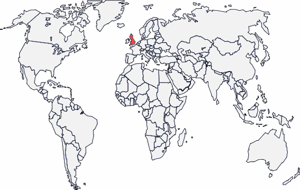 Carbon (Graphite) Carbon (Graphite) |
| Deposits of graphite in Borrowdale, Cumberland, England were at first of sufficient size and purity that, until the 1800s,
pencils were made simply by sawing blocks of natural graphite into strips before encasing the strips in wood. Today, smaller
deposits of graphite are obtained by crushing the parent rock and floating the lighter graphite out on water.
|
 Calcium Calcium |
| In 2006, the UK produced approx. 60000 tonnes of fluorspar (CaF2). World production was around 5.5 million tonnes.
|
| The UK's production of gypsum (CaSO4.2H2O) in 2006 was approx. 1.7 million tonnes. World production of gypsum in 2006 was 142.5 millions tonnes.
|
 Iron Iron |
| The UK's production of iron ore in 2006 was 341 tonnes. Total world production of iron ore in 2006 was 1.81 billion tonnes. |
| Production of pig iron in the UK in 2006 was 10.6957 million tonnes. Total world production of pig iron in 2006 was 925.8
million tonnes.
|
 Nickel Nickel |
| The UK's combined smelter/refinery production of nickel in 2006 was 15900 tonnes. Worldwide smelter/refinery production of
nickel in 2006 was 1.337 million tonnes.
|
 Gallium Gallium |
| Data on world production of primary gallium are unavailable because data on the output of the few producers are considered
to be proprietary.
|
| In 2007, world primary production was estimated to be about 80 metric tons. China, Germany, Japan, and Ukraine were the leading producers. |
| Countries with smaller output were Hungary, Kazakhstan, Russia, and Slovakia. Refined gallium production was estimated to be about 103 metric tons; this figure includes some scrap refining. |
| Gallium was recycled from new scrap in Germany, Japan, the United Kingdom, and the United States. |
 Bromine Bromine |
| In 2002/3, the UK produced approx. 25000 tonnes, but nothing in 2004/5/6. |
 Tin Tin |
| European tin mining is believed to have started in Cornwall and Devon (esp. Dartmoor) in England in Classical times, and a
thriving tin trade developed with the civilizations of the Mediterranean. The last Cornish tin mine, at South Crofty near
Camborne, closed in 1998 bringing 4,000 years of mining in Cornwall to an end, but as of 2007 increased demand from China may lead to its re-opening.
|
| Historical Cornwall was the major tin producer, this changed after large amounts of tin have been found in the Bolivian tin
belt and the east Asian tin belt stretching from China through Thailand and Laos to Malaya and Indonesia.
|
 Barium Barium |
| In 2006, the UK produced approx. 47000 tonnes of barytes (BaSO4), the main source of barium. World production of barytes in 2006 was 8.8 million tonnes.
|
 Europium Europium |
| Divalent europium in small amounts happens to be the activator of the bright blue fluorescence of some samples of the mineral
fluorite (calcium difluoride). The most outstanding examples of this originated around Weardale, and adjacent parts of northern
England, and indeed it was this fluorite that gave its name to the phenomenon of fluorescence, although it was not until much
later that europium was discovered or determined to be the cause.
|
 Lead Lead |
| In 2006, the UK produced approx. 500 tonnes of lead from mining. The total amount of lead mined in 2006 was 3.5 million tonnes. |
| In 2006, the UK's production of refined lead was 306737 tonnes. Total world production of refined lead in 2006 was 8 million
tonnes.
|
 Protactinium Protactinium |
| In 1961, the United Kingdom Atomic Energy Authority was able to produce 125g of 99.9% pure protactinium, processing 60 tons
of waste material in a 12-stage process and spending 500,000 USD. For many years, this was the world's only supply of the
element.
|


 Carbon (Graphite)
Carbon (Graphite) Calcium
Calcium Iron
Iron Nickel
Nickel Gallium
Gallium Bromine
Bromine Tin
Tin Barium
Barium Europium
Europium Lead
Lead Protactinium
Protactinium